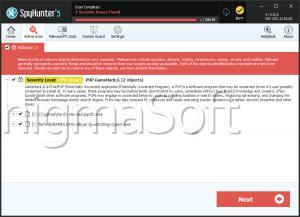2700 Ransomware
The ransomware variant identified as 2700 was discovered during the analysis of potential malware threats. This harmful software employs a file encryption mechanism, where it encrypts files and appends specific information to filenames. The appended data includes the victim's ID, the email address sqlback@memeware.net, and a '.2700' extension.
In addition to its encryption operations, 2700 leaves behind two ransom notes, named 'info.txt' and 'info.hta,' as part of its modus operandi. These notes typically contain instructions and demands from the attackers regarding the ransom payment for the decryption key.
To illustrate how 2700 modifies filenames, consider the following examples: '1.png' may be transformed into '1.jpg.id[9ECFA74E-3524].[sqlback@memeware.net].2700,' and '2.doc' might become '2.png.id[9ECFA74E-3524].[sqlback@memeware.net].2700.' This pattern of file renaming showcases the consistent method used by 2700 in appending victim-specific information to the encrypted files. Users encountering this ransomware variant should exercise caution and apply adequate security measures to protect their data and systems. The 2700 Ransomware has been linked to the Phobos malware family.
The 2700 Ransomware Extorts Its Victims for Money by Taking Data Hostage
The ransom note associated with the 2700 Ransomware provides detailed instructions for victims to establish contact with the perpetrators through the specified email address, sqlback@memeware.net, using a unique ID mentioned in the subject of the message. The ransom demand, typically payable in Bitcoins, varies based on the speed of the victim's response to the ransom note.
To encourage compliance, the note offers a limited opportunity for victims to send up to 2 files for free decryption, provided the total size does not exceed 2 megabytes and the files are deemed non-critical. The instructions also guide victims on the process of obtaining Bitcoins, caution against renaming encrypted files, and advise against attempting decryption with third-party software, which may result in permanent data loss.
Significantly, 2700 takes strategic actions to compromise the targeted system's defenses. It disables the firewall, a fundamental security measure, weakening the overall protection of the system. Additionally, the ransomware eliminates the Shadow Volume Copies, foreclosing potential avenues for data recovery. Exploiting vulnerabilities in Remote Desktop Protocol (RDP) services, 2700 gains unauthorized access through brute force and dictionary attacks, particularly on systems with poorly managed account credentials.
Beyond its encryption and compromise functionalities, 2700 exhibits advanced capabilities. It collects location data and possesses the ability to exclude specific predefined locations, thereby enhancing its longevity and impact. These multifaceted tactics make 2700 a formidable threat, underscoring the importance of having comprehensive cybersecurity practices and heightened awareness to counteract its detrimental effects.
It is Paramount to Establish Robust Security Measures on All Devices
Protecting devices from ransomware threats requires a comprehensive approach encompassing a combination of preventive measures and proactive practices. Here are essential measures users should always implement to safeguard their devices against ransomware:
- Regular Backups: Creating regular backups of your important data on external and offline storage is crucial. This ensures that even if the device is compromised, users can restore the impacted files without succumbing to ransom demands.
- Security Software: Install reputable anti-malware software on all devices. Then, make sure to keep the software updated and execute regular scans to detect and remove potential threats, including ransomware.
- Software Updates: Always install new updates for your software and operating system always updated with the latest security patches. Regular updates help close vulnerabilities that ransomware and other malware may exploit.
- Email Security Awareness: Exercise caution when opening email attachments or reacting to links, especially in emails from unknown or suspicious sources. Be vigilant against phishing attempts, a common method for initiating ransomware attacks.
- User Education: Educate yourself and your users about the dangers of ransomware. Train them to be able to recognize phishing attempts, suspicious links, and the importance of not downloading files from untrusted sources.
- Least Privilege Principle: Embrace the principle of least privilege. Restrict user access rights to only what is necessary for their role, reducing the potential impact if an account is compromised.
- Network Segmentation: Perform network segmentation to isolate critical systems from the rest of the network. This prevents the lateral movement of ransomware within a network.
By consistently implementing these measures, users can significantly maximize the security posture of their devices and minimize the probability of falling victim to ransomware attacks.
Victims of the 2700 Ransomware are left with the following ransom note:
'All your files have been encrypted!
All your files have been encrypted due to a security problem with your PC. If you want to restore them, write us to the e-mail sqlback@memeware.net
Write this ID in the title of your message 9ECFA84E-3524
You have to pay for decryption in Bitcoins. The price depends on how fast you write to us. After payment we will send you the tool that will decrypt all your files.
Free decryption as guarantee
Before paying you can send us up to 2 files for free decryption. The total size of files must be less than 2Mb (non archived), and files should not contain valuable information. (databases,backups, large excel sheets, etc.)
How to obtain Bitcoins
The easiest way to buy bitcoins is the OKX website. You must register, click "Buy Bitcoins" and select a merchant by payment method and price.
hxxps://okx.com
You can also find other places to buy bitcoins and a beginner's guide here:
hxxp://www.coindesk.com/information/how-can-i-buy-bitcoins/
Attention!
Do not rename encrypted files.
Do not try to decrypt your data using third party software, it may cause permanent data loss.
Decryption of your files with the help of third parties may cause increased price (they add their fee to our) or you can become a victim of a scam.The text file created by 2700 Ransomware delivers the following message:
!!!All of your files are encrypted!!!
To decrypt them send e-mail to this address: sqlback@memeware.net.'


